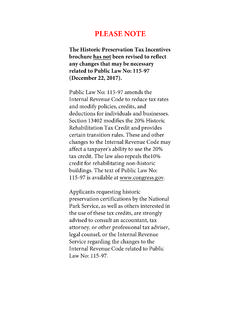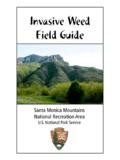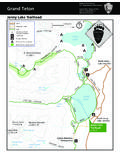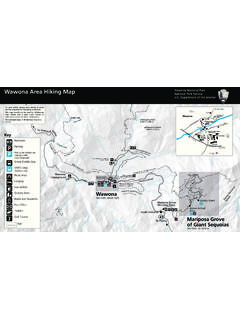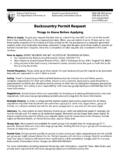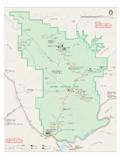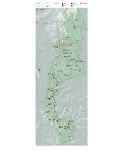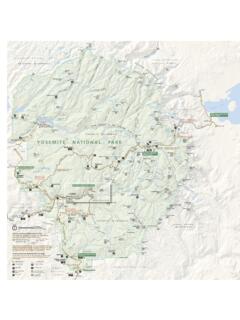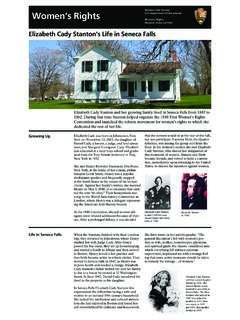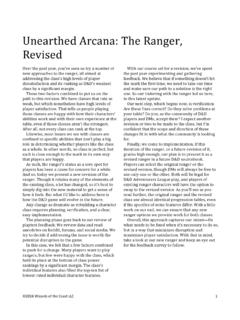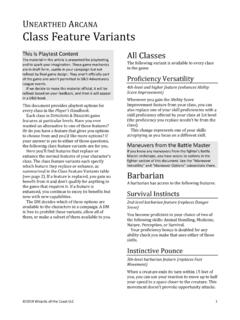Transcription of Foundations of Interpretation - NPS
1 NPS Interpretive Development Program 3/1/07 Professional Standards for Learning and Performance 1 National Park Service Department of the Interior Interpretive Development Program Foundations of InterpretationCurriculum Content Narrative Foundational Competencies for All NPS Interpreters This is the revised and updated curriculum for what was formerly known as Fulfilling the NPS Mission: the Process of Interpretation (Module 101). It builds and evolves from those original ideas and the input of many interpretive professionals who have contributed. This revised curriculum presents the competency descriptions and competency standards for the following NPS core interpretive competencies: Foundations of Interpretation , Knowledge of the Resource, Knowledge of the Audience, and Knowledge of Appropriate Techniques. Authors of this document: Kevin Bacher Interpretive Park ranger , Mount Rainer National Park Alyssa Baltrus Supervisory Park ranger , C&O Canal National Historical Park Beth Barrie Curriculum Designer, Eppley Institute for Parks and Public Lands Katie Bliss Curriculum Revision Coordinator, Eppley Institute for Parks and Public Lands Dominic Cardea Chief of Interpretation , Haleakala National Park Linda Chandler Interpretive Park ranger , Castillo De San Marco National Monument Dave Dahlen Superintendent, Mather Training Center Jana Friesen Natural Resources Program Writer, Washington Office Richard Kohen Interpretive Specialist, Intermountain Support Office Becky Lacome Training Specialist, Mather Training Center Foundations of Interpretation Competency Description National Park Service Interpretation directly supports the preservation mission.
2 Interpretation is driven by a philosophy that charges interpreters to help audiences care about park resources so they might support the care for park resources. Interpretation establishes the value of preserving park resources by helping audiences discover the meanings and significance associated with those resources. This competency requires interpreters at all levels to understand the core definition of Interpretation , the professional standards for Interpretation , the purpose of Interpretation , how Interpretation can be measured, and how successful Interpretation works. These understandings continually evolve and increase in sophistication throughout an interpreter s career. Entry level interpreters use this philosophy and best practices to create interpretive products. Full performance interpreters use these philosophies and best practices to refine interpretive products as well as to plan and deliver special events, interpretive media, and other interpretive activities.
3 Supervisors and managers use these philosophies and best practices to articulate, apply, and measure interpretive choices and functions, and to support the work of resource management and preservation. All interpretive applications, evaluation, and training should incorporate the philosophies and best practices contained in Foundations of Interpretation . Competency Standard All Interpreters: Understand their role to facilitate connections between resource meanings and audience interest. Understand their role to facilitate connections between resource meanings and audience interests. Understand, recognize, and create opportunities for audiences to make their own intellectual and emotional connections to resource meanings. NPS Interpretive Development Program 3/1/07 Professional Standards for Learning and Performance 2 Understand, recognize, and cohesively develop an idea or ideas in interpretive products and activities.
4 Understand the roles and relationships of resource knowledge, audience knowledge, and interpretive techniques in interpretive products and activities. Purposefully reflect on interpretive philosophies and best practices, deepen their understandings, and apply these philosophies and best practices to all interpretive competencies. What is Effective Interpretation ? What is an interpreter? When most people hear the word interpreter they think of someone who translates the meaning of one language into another. In a museum, zoo, or park setting interpreters translate artifacts, collections, and physical resources into a language that helps visitors make meaning of these resources. Credit for using the word Interpretation to describe the work of exhibit designers, docents, and naturalists goes to John Muir who penned in his Yosemite notebook: I'll interpret the rocks, learn the language of flood, storm and the avalanche.
5 I'll acquaint myself with the glaciers and wild gardens, and get as near the heart of the world as I can." (John Muir, 1896) The word Interpretation is, at times, awkward for describing what naturalists, exhibit designers, docents, and park rangers do because it does not always adequately capture the full range of what an interpreter does. Another term for interpreters could be visitor experience specialists. They provide orientation, information and inspiration in the right amounts and at the right times so that visitors will have more enjoyable, meaningful and complete experiences. The history of Interpretation Interpretation , as a profession, has evolved over time. Some of the important people who helped define and develop the profession of Interpretation are listed, with their significant contributions, below. John Muir, (April 21, 1838 December 24, 1914) was one of the earliest modern preservationists.
6 His letters, essays, and books telling of his adventures in nature, and wild life, especially in the Sierra Nevada Mountains of California, were read by millions and are still popular today. His direct activism helped to save the Yosemite Valley and other wilderness areas. The Sierra Club, which he founded, is now one of the most important conservation organizations in the United States. But more than that his vision of nature's value for its own sake and for its spiritual, not just practical, benefits to humankind helped to change the way we look at the natural world. (Wikipedia, 2006) (taken from , retrieved December 14, 2006) Enos Mills (1870-1922) founded the first nature guide school after serving as a guide to his various hotel guests. He became the prime motivator for creating Rocky Mountain National Park. His enthusiasm for preservation flourished during a serendipitous friendship.
7 While walking on the beach near San Francisco he asked an elderly passerby about a piece of kelp he found. The passerby just happened to be John Muir and his response about the kelp started an enduring friendship. Muir encouraged Enos to join the conservation movement and write about his adventures in nature. Mills wrote 20 books including Adventures of a Nature Guide, a work that is still relevant to interpreters. NPS Interpretive Development Program 3/1/07 Professional Standards for Learning and Performance 3 Freeman Tilden, (1883-1980) a newspaper columnist and author, decided he needed a change in his life at age 58. When his friend National Park Service Director Newton Drury invited him to work with the National Park Service, he entered the field of Interpretation and forever changed the profession. In traveling to various parks to write books about the national park system he became concerned about the quality of interpretive programs in parks.
8 This concern eventually led him to write his foundational book, Interpreting Our Heritage, published in 1957. It is in Interpreting Our Heritage that Tilden outlines his enduring principles of Interpretation : 1. Any Interpretation that does not somehow relate what is being displayed or described to something within the personality or experience of the visitor will be sterile. 2. Information, as such, is not Interpretation . Interpretation is revelation based upon information. But they are entirely different things. However, all Interpretation includes information. 3. Interpretation is an art, which combines many arts, whether the materials presented are scientific, historical or architectural. Any art is in some degree teachable. 4. The chief aim of Interpretation is not instruction, but provocation. 5. Interpretation should aim to present a whole rather than a part, and must address itself to the whole man rather than any phase.
9 6. Interpretation addressed to children (say, up to the age of twelve) should not be a dilution of the presentation to adults, but should follow a fundamentally different approach. To be at its best, it will require a separate program. (Freeman Tilden, 1957) William J. Lewis s Interpreting for Park Visitors, first published in 1980, provided practical wisdom and guidance for presenting specific kinds of interpretive programming. Like Tilden s book, Lewis s book remains a valuable classic that has helped establish the profession of Interpretation and continues to be useful and relevant. In the Fine Art of Interpretive Critiquing and The Process of Interpretive Critiquing, Lewis also provided some of the first training and guidance in interpretive coaching. Sam Ham directs the Center for International Training and Outreach at the University of Idaho s College of Natural Resources, where he is a professor in the Department of Resource Recreation and Tourism.
10 His book Environmental Interpretation (1992) contained 4 qualities that distinguish Interpretation from other communication. These qualities have become central to the profession of Interpretation . 1. Interpretation is pleasurable. 2. Interpretation is relevant. 3. Interpretation is organized. 4. Interpretation has a theme. Larry Beck and Ted Cable authored the book Interpretation for the 21st Century (1998) to provide direction in the field at the turn of the millennium. As professors that teach coursework in Interpretation they have written extensively in the fields of natural resource management and Interpretation . Building upon the work of Enos Mills and Freeman Tilden, they developed Fifteen Principles of Interpretation : 1. To spark an interest, interpreters must relate the subject to the lives of visitors. 2. The purpose of Interpretation goes beyond providing information to reveal deeper meaning and truth.
